Blueberries are a cool weather crop. So perish the thought of cultivating them in your Southern California backyard, right?
Wrong, because in California’s favorable soil and (mostly) temperate conditions, it’s possible to grow almost anything — except maybe your bank account if you’re a renter.
It takes a little foresight, determination, and a willingness to adapt, but it can be done — and we’ll show you how.
Blueberries & ‘Chill Hours’
Chill hours refer to the time that temperatures remain below 45°F during the dormant winter months. This period of cool temperatures stimulates blueberries to break dormancy and produce blooms and fruit in the spring.
Fortunately, some blueberry cultivars are more forgiving and can tolerate fewer chill hours, making them suitable for warmer climates.
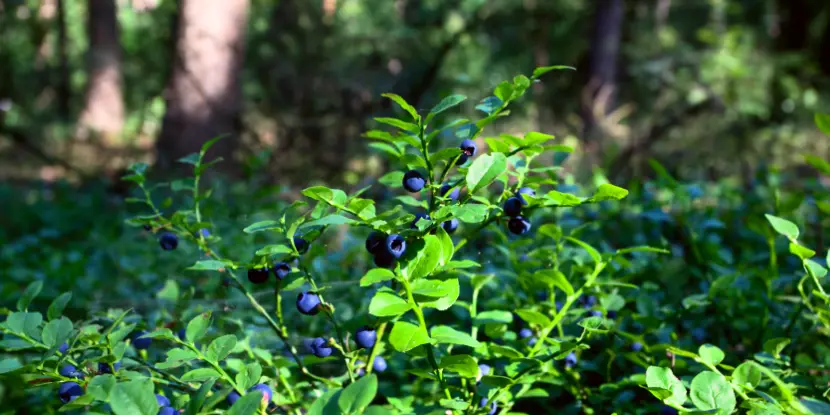
Wild blueberries in the woods.
Best Blueberry Varieties for Southern California
Look for varieties bred to withstand warmer temperatures with fewer chill hours. Blueberries are perennial plants, meaning they’ll return year after year with proper care.
Vaccinium ‘Sunshine Blue’ Dwarf Blueberries
- Chill hours: 150.
- Very adaptable to a wide range of conditions.
Southern Highbush
- Chill hours: 150-500.
- Popular varieties include ‘Sunshine Blue,’ ‘Misty,’ and ‘Sharp Blue.’
Emerald Blueberries
- Chill hours: 250-350.
- Adaptable to various climates, including warmer regions.
- Known for their large berry size and high yield.
Jewel Blueberries
- Chill hours: 200-300.
- Vigorous growers with an abundant crop of tasty, aromatic berries.
O’Neal Blueberries
- Chill hours: 200–300.
- Distinctive, sweet-tasting berries.
- Can thrive in higher temperatures.
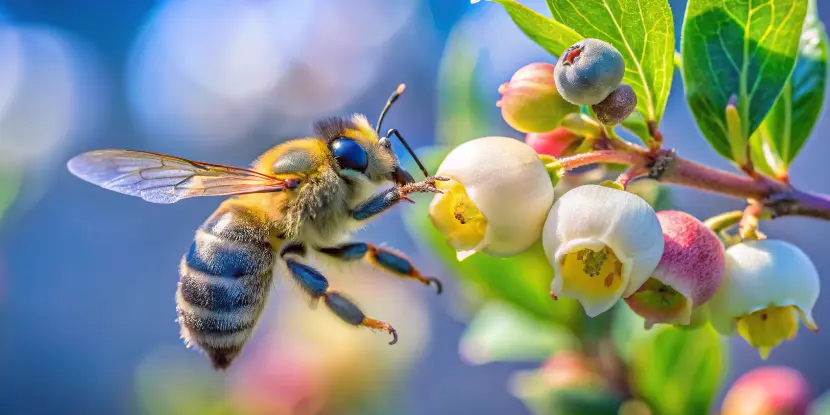
A bee pollinates a blueberry flower.
Propagating Blueberry Bushes
Cuttings
- Semi-Hardwood Cuttings (late summer): Trim mature stems from the current season’s growth, around 4–6 inches long. Strip leaves from the lower third of each cutting, then dip the cut end in rooting hormone to encourage root development.
- Hardwood Cuttings (late winter or early spring): Gather cuttings from well-ripened wood while plants are still dormant. Cut segments around 4–8 inches long, ensuring each has several nodes. As with semi-hardwood cuttings, remove lower leaves and apply rooting hormone before planting.
- Softwood Cuttings (late spring or early summer): Choose new growth when stems are supple. Cut 4–6 inch segments and remove the lower leaves. Use a rooting hormone, then place cuttings in a moist growing medium and cover them with plastic to retain humidity.
Seeds
Blueberries grown from seeds take longer to mature and bear fruit. Seeds are generally less reliable than cuttings because seed-grown plants may retain only some of the desirable traits of the parent plant.
Division
This method involves separating the root system of a mature blueberry bush. It can be done when transplanting or maintaining a blueberry plant.
How Long Before Blueberry Bushes Bear Fruit?
During the first year after planting, bushes produce little or no fruit as they focus on establishing their root systems. You might see a small yield by the second year, but substantial fruit production usually begins in the third year.
Ensure the bushes receive proper care, including adequate sunlight, water, and nutrition for optimal growth and fruiting.
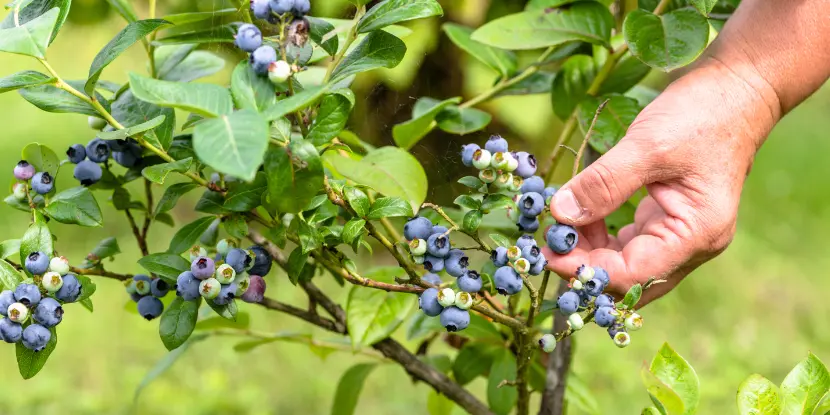
A young blueberry bush beginning to bear fruit.
Soil Preparation
- Blueberries prefer acidic soil with a pH between 4.0 and 5.5.
- If your soil is alkaline, you can lower the pH by adding organic matter like peat moss, pine needles, or coffee grounds.
- Incorporate organic material like compost, and consider planting on slopes or raised beds to facilitate drainage.
- Test your soil regularly and make necessary adjustments.
- Avoid heavy clay soils unless they can be amended to improve drainage.
Sunlight & Temperatures
- Blueberries need at least 6–8 hours of direct sunlight daily.
- Plant them in areas where they can capture the morning sunlight while still having some protection from intense afternoon heat.
- Consistently moderate temperatures are ideal for blueberries, with a maximum range of 60–85°F.
- Consider using shade cloths or planting blueberries near taller plants to reduce heat stress without sacrificing too much sunlight.
- Avoid planting in frost pockets or areas with extreme temperature shifts.
Planting Blueberries
- The optimal time to plant blueberry bushes in Southern California is late fall or early spring.
- This is when the plants are dormant, and cooler temperatures make it easier for them to establish their root system.
- Dig a hole twice the width of the root ball and slightly deeper than the depth of the pot.
- Loosen the soil along the hole’s edges to encourage root penetration and growth.
- Space plants at least 4–5 feet apart to allow for airflow and growth.
- Remove the blueberry plant from its container, gently loosening any root-bound clumps.
- Position the bush in the center of the hole, ensuring the root crown is slightly above the soil line.
- Backfill with soil, pressing firmly around the roots to remove air pockets.
- Water thoroughly after planting to settle the soil around the roots and help with establishment.
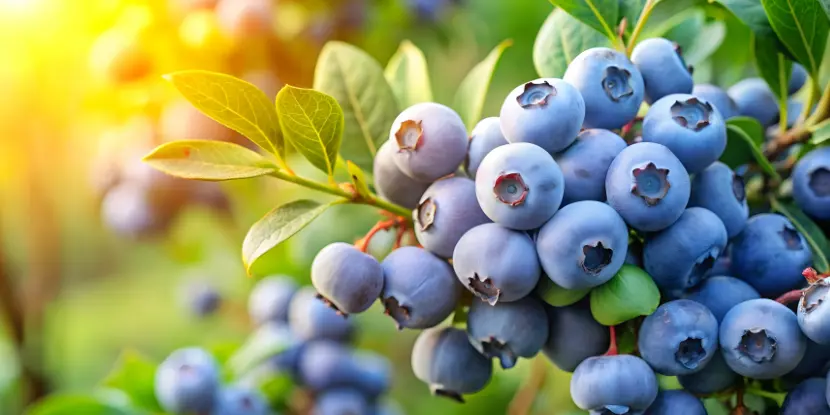
A cluster of ripe blueberries ready to be picked.
Irrigation
- Blueberries have shallow root systems and require consistent moisture but not standing water.
- When establishing new plants, water deeply once or twice weekly until they develop a robust root system.
- After that, adjust your watering schedule based on the weather and soil type. In Southern California’s dry climate, watering 2–3 times weekly is usually sufficient.
- Consider using drip irrigation or soaker hoses to deliver water directly to the roots without wetting the foliage, which can lead to diseases.
Mulching & Fertilization
- Apply mulch around the base of the plant to help retain moisture and suppress weeds.
- Use an acidic organic mulch like pine needles, sawdust, or bark chips.
- Fertilize with an acid-based fertilizer once in the spring and again in the fall.
- Avoid using synthetic fertilizers or those high in nitrogen, which can damage blueberry bushes.
Pruning & Maintenance
- Blueberries require minimal pruning for the first three years after planting.
- After that, prune annually to remove damaged or weak branches and maintain a balanced shape.
- Remove low-hanging branches near the ground to prevent fungal diseases and increase airflow.
- In late winter or early spring, remove any dead or diseased wood.
- Regularly check for pests like aphids, mites, and thrips, and treat them with organic methods if necessary.
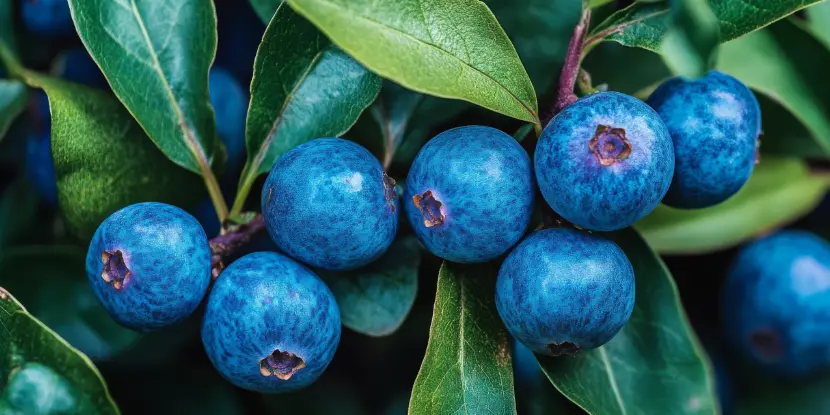
Close-up of ripe blueberries on the bush.
Container Gardening
Is your outdoor space limited? You can still enjoy fresh blueberries by growing them in containers on a patio or balcony.
- Choose dwarf varieties bred for container growing.
- Use a pot with drainage holes and fill it with acidic potting mix.
- Water regularly, but avoid overwatering, as containers retain more moisture than garden soil.
- Fertilize every 4–6 weeks using an acid-based fertilizer.
- Prune annually to maintain a balanced shape and remove dead or diseased branches.
Growing blueberries in containers also makes it easier to protect them from pests, birds, and heat. You can move plants indoors temporarily.
Harvesting Blueberries
- Wait until berries are fully ripe. They don’t continue to ripen after picking.
- Ripe blueberries are uniformly colored and easily detach from the stem with a gentle twist.
- Harvest in the morning when temperatures are cool to preserve berry quality.
- Handle berries gently to avoid bruising, and refrigerate them promptly to extend shelf life.
- Regular picking encourages continued production. During peak season, visit your plants every few days to collect ripe berries and promote new growth.

Blueberry muffins, anyone?
FAQs: Growing Blueberries
Q: Can blueberries grow in pots?
Blueberries can thrive in pots, making them ideal for small spaces or patios. Use a pot with good drainage and at least 18 inches in diameter. Select an acidic potting mix and follow regular watering and fertilizing practices.
Q: How can I protect blueberries from birds?
Birds love blueberries as much as we do. To protect your harvest, cover plants with bird netting or mesh. You can also try scare tactics like reflective tape or decoys, but netting is most effective and humane.
Q: When is the best time to prune?
Prune blueberries in late winter or early spring before new growth begins. Remove dead or diseased wood and thin, crowded branches to improve air circulation and light penetration. Regular pruning revitalizes plants and enhances fruiting.
Q: How can I improve the soil for blueberries naturally?
Add organic matter such as peat moss or pine bark to the planting area to enhance soil texture and acidity. Regularly applying organic mulch can further improve soil structure and fertility over time.
Q: Are there any companion plants for blueberries?
Blueberries benefit from being planted near other acid-loving plants like cranberries, rhododendrons, and azaleas. Avoid planting them near crops that require high nitrogen levels, which is detrimental to blueberry bushes.
Q: How do I store harvested blueberries for long-term use?
Wash and dry them thoroughly, then freeze them on a baking sheet before transferring them to an airtight container. This method prevents clumping and retains the berries’ quality for up to a year.

